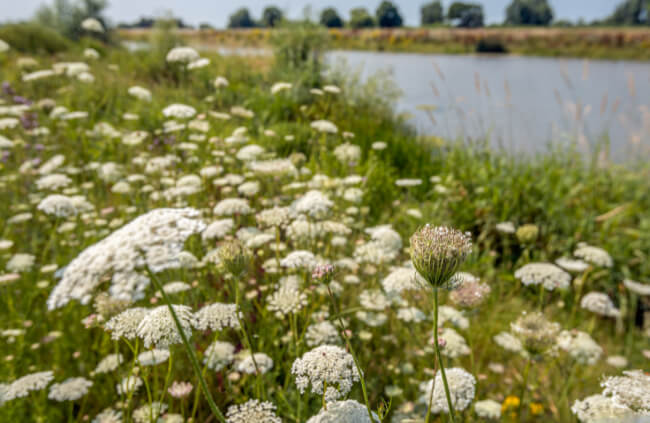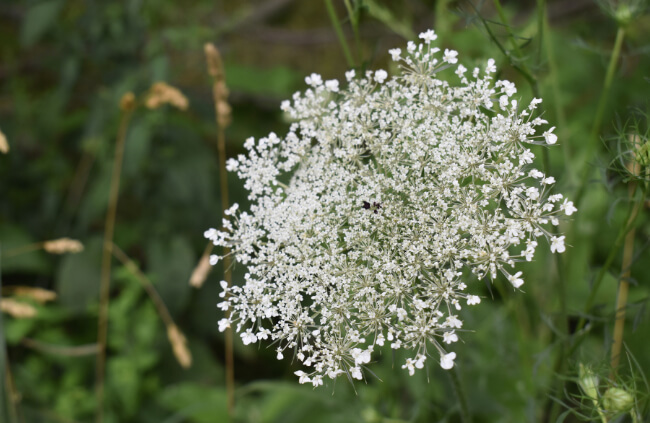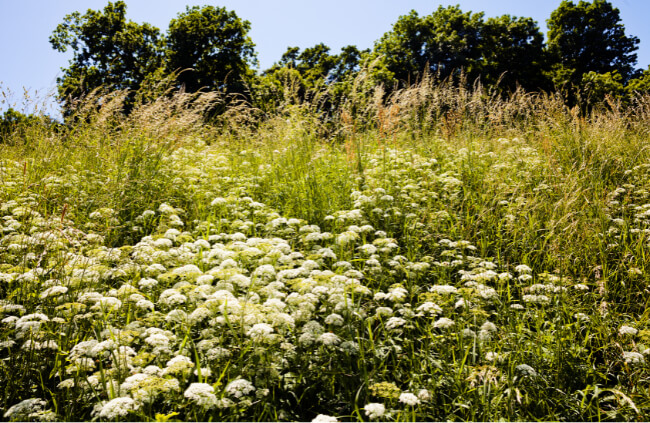Wildflowers might well make you think of native plants, but often those semi-invasive species that are introduced on the boots of travellers, are just as valuable to our wildlife. Wild Carrot, or Queen Anne’s Lace, is just one of those flowers.
As a plant that requires few nutrients, it can outcompete some native species, but it seems to live quite well alongside most, and offer a wonderful source of pollen and nectar to bees and butterflies alike.
To grow this delicate umbellifer at home, follow our simple guide below. You truly can’t go wrong.
More...

Family: | Apiaceae |
|---|---|
Genus: | Daucus |
Species: | D. carota |
Origin: | Europe |
Common Names: | Wild Carrot, Bishop’s lace, Queen Anne’s lace |
Location: | Outdoor |
Type: | Hardy biennial |
Growth: | Up to 1 m tall (generally 30 cm) |
Sun requirements: | Full sun |
Foliage Colour: | Green |
Flower Colour: | White |
Flowering: | Summer |
Edible Parts: | All parts of the plant are edible, including seeds |
Maintenance level: | Low |
Poisonous for pets: | Non-toxic to cats & dogs |
Getting to Know Queen Anne’s Lace

Queen Anne’s Lace is a delicate wildflower, native to Europe and Asia, but not endemic through Australia and North America. In warmer climates it can grow as an annual, or a biennial, depending on the heat of the summer, which can cause flowering in the first year.
Its scientific name is Daucus carota, the wild carrot. And yes, it is actually edible, from the flower right down to the root. You only need to brush its foliage to get that distinct carroty, parsley smell (in Europe it is also commonly known as cow parsley).
This biennial wildflower takes a year to establish, with short, frilly foliage that hides in plain sight, while its seed develops into a long taproot. In early summer of the second year, that root will send up a mass of lacy foliage, followed by a single, white, plate-shaped flower.
Wild Carrot’s Natural Habitat
Queen Anne’s Lace is native to Europe and Asia, and is able to grow on any free-draining soil. It grows in cracks between pavements, sandy river banks, and cultivated soil with equal levels of ease, and its seed is widely distributed by wind, insects and rain.
It will grow and flower in nearly all conditions and its seed and roots are both completely frost hardy, so will germinate and re-flower after the heaviest of winter frosts, or the direst of summers.
How to Grow Queen Anne’s Lace
Daucus, while naturally occurring, is also cultivated into multiple ornamental forms, and various edible and colourful varieties. All will grow in the same method as described below, but the easiest to grow for its flowers will always be good, old fashioned, Queen Anne’s Lace.

When to Sow Queen Anne’s Lace
Sow wild carrots where you want to flower from spring through the early autumn. Provided it germinates in its first year, it should flower the following year.
How to Propagate Wild Carrot from Seeds
You can sow wild carrot in seed trays by sprinkling seed on the surface and watering it in, but it is hard to move once it begins to root, and does not like to be planted out.
Rather than sowing into seed trays, sow a pinch of Queen Anne’s Lace seed into a small pot in late spring, and water it. Leave it outdoors, somewhere discrete and protected from afternoon sunshine until next spring.
At that point, it should be stable enough to plant directly into the garden and will flower in about six weeks’ time.
Preparing the Ground for Wild Carrot
All Daucus like poor soil. Fresh compost or manure will ruin your roots, whether you’re planning on harvesting them as a food, or just enjoying their flowers.


Get Your Free Guide:
Master Growing Australian Natives eBook
A Must Have Complete Guide for Every Australian Garden
Get Your Free Guide:
Master Growing Australian Natives eBook
A Must Have Complete Guide for Every Australian Garden
If you have poor, sandy soils, that’s perfect. On clay soils, mix through as much used, old compost as possible to break the soil up and aid drainage.
Where to Grow Queen Anne’s Lace
Wild carrot will grow in beds, borders, pots and pretty much anywhere you want it to, but for best results, plant it either into lawns, or mixed borders, where the competition from other annual and biennial planting will encourage it to grow taller, sometimes reaching up to 1.5m tall.
Growing Wild Carrot in Borders
To grow wild carrots in borders, especially mixed borders, it’s important to prepare the soil by weeding, and then clearing slightly in spring. In the open space, sow Queen Anne’s Lace seeds in a patch (it looks much better in clumps, rather than dotted through other ornamentals) and then water it in. In the first year, it won’t be exciting, but will add a gentle layer of frilly foliage.
In its second year you’ll be rewarded with undulating umbels of white flowers.
Tip: To make the most of Queen Anne’s Lace in any situation, pinch out the shoots at the start of their second year. This will encourage at least double the amount of flowers. As flowers go to seed, make sure you deadhead ripe seeds and drop them back into the same patch for next year’s flowers.
Growing Wild Carrot in Lawns
Wild carrots grow shockingly well in lawns. Despite disliking compacted soil, it will produce wiry, thin roots, and mid-height fine stems. The white flowers stand out against long grass, and look brilliant while you wait for other wildflowers to establish.
How to Care for Wild Carrot
Queen Anne’s Lace requires very little ongoing care, if any. In early summer, they benefit from watering, which can boost their flowering potential for the year, but they don’t require any fertiliser, or mulch at any point.
The only real ongoing tip for growing Queen Anne’s Lace is deadheading. It’s up to you when you deadhead but it’s pretty much essential. The seeds of Queen Anne’s Lace will spread around your garden, so either deadhead when flowers are finished, before seeds develop, or as soon as seeds ripen, so you can re-sow them in the same spot.
Harvesting and Using Wild Carrot
Queen Anne’s Lace, or wild carrot, is a completely edible plant. Its roots are tougher than cultivated carrots (Daucus carota subsp. sativus) but can be cooked when young in their first year, before they flower.

Using Wild Carrot Leaves
Wild carrot leaves and flowers are also edible, with a delicate flavour and texture to add to salads. They can be diced and wilted in soups as an alternative to parsley too.
You can harvest and use Queen Anne’s Lace leaves at any point in their lifespan.
How to Prepare Wild Carrot Roots
There are two ways to prepare Queen Anne’s Lace for edible use. The first is to harvest and wash young roots before their first winter. The young roots are thinner and paler than normal carrots, but with a similar flavour, and can be cooked in just the same way.
Older roots can be harvested at any time, and roasted before being left to dry out completely, ground into a powder, and used as an earthy, caffeine free, coffee substitute.
Common Queen Anne’s Lace Pests and Diseases
Blights and fungal problems are common problems for Queen Anne’s Lace. The only real solution is prevention, as disturbing the roots will inevitably mean brushing fungal problems from one plant to the next.
To prevent fungal issues with Queen Anne’s Lace, avoid watering it unless absolutely necessary. It does not like humidity, and its roots are designed to search for water as deep as they possibly can. The more neglect you give them, the tougher they will be, and the less at risk of leaf blight.
In terms of root protection, wild carrots grown for flowers will still flower if their roots are distributed, but root weevils and wireworms will damage roots, and they usually don’t come back the following year as a result.
If that happens, or you notice Queen Anne’s Lace not growing back in its third or second year, dig up the roots. If they have holes in or have rotted, avoid planting them or any other member of the carrot family there for at least three years.
Queen Anne’s Lace Frequently Asked Questions

Is Queen Anne’s Lace invasive?
Wild carrot is an invasive and thuggish plant if not deadheaded. Its seeds will spread readily around gardens into most soil types.
Does Queen Anne’s Lace come back every year?
Queen Anne’s Lace comes back every year, flowering for up to six years after its second year. They are strictly a biennial, but in nearly all conditions will continue to grow as a short-lived perennial.
Is Queen Anne’s Lace toxic?
Queen Anne’s Lace is not toxic, but some people do have skin allergies to it and may develop a short-lived rash after contact.
Is Queen Anne’s Lace good for bees?
Queen Anne’s Lace is a brilliant plant for bees and pollinators. Its umbellifer flowers offer open access to pollen and a clear landing pad that any pollinator can access with ease.
Is Queen Anne’s Lace safe for dogs?
Wild carrot, Queen Anne’s Lace, is safe for dogs and cats. It is very closely related to typical culinary carrots, which are often used as an ingredient in both dog and cat food.
Do birds eat Queen Anne’s Lace seeds?
If you have an abundance of ripe Queen Anne’s Lace seeds, they can be used on the bird table. Short beaked birds love them, and will eat them up, saving you a ton of weeding next year!
How do you get rid of Queen Anne’s Lace?
As well as being a beautiful ornamental wildflower, Queen Anne’s Lace can become a problem if not managed properly. In lawns, it’s easy to remove. Simply mow regularly, and in a few years it will stop growing and the tap root will die.
In beds and borders, dig out the entire root, and deadhead any flowers before they have a chance to set seed.
Wrapping Up Our Guide to Growing Queen Anne’s Lace or Wild Carrots
Queen Anne’s Lace, or Daucus carota, is a fabulous wildflower, but like all wildflowers, it is successful because it is easy to grow, and will establish in most conditions. So, it’s not a plant for the faint hearted, and while it is very low maintenance in itself, it does increase maintenance around the rest of the garden if left unchecked.
Grow your own Queen Anne’s Lace with ease by following this guide, but be sure to deadhead it properly, whether you want it to spread or not. That way, you stay in control.
Published on August 15, 2023 by Maisie Blevins
Last Updated on February 5, 2025




